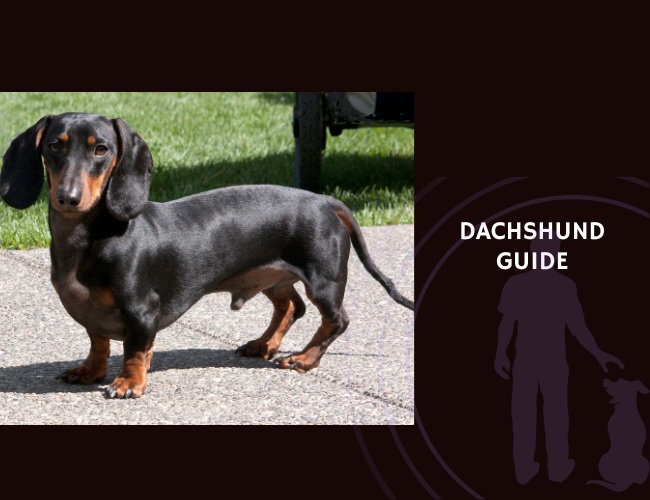Introduction to the Dachshund Breed
A Brief Look Back: From Hunters to Household Favorites
Imagine exploring the forests of 16th-century Germany. On your heels is the determined, low-to-the-ground Dachshund, eager to burrow and track. Originally bred as a tenacious hunting dog, the Dachshund was designed to hunt badgers and other burrowing animals. Their name even means “badger dog” in German! These small but mighty dogs used their keen noses, courage, and persistence to pursue prey underground—a job demanding both physical specialization and bold character.
Distinctive Physical Traits
You can spot a Dachshund from across the park thanks to their unmistakable silhouette. Their long, sturdy bodies and short, muscular legs create a “sausage dog” shape that’s both adorable and highly functional. This unique build allowed them to slip into animal burrows without hesitation. Their tails, strong and straight, served as a handy handle for hunters to pull them from tight spots. Their expressive faces, big eyes, and long ears make them especially charming. Dachshunds come in three coat types: smooth, long-haired, and wire-haired, each adding a different flair to their appearance.
Beloved Companions Around the World
Today, Dachshunds are much more likely to be found curled up on a couch than chasing badgers. Their spunky personalities and unwavering loyalty have won over families globally. They’re widely recognized for their affectionate nature with loved ones, though their protective instincts remain strong. Dachshunds rank among the most popular small breeds, earning recognition from kennel clubs and pet lovers alike. Whether as a playful pet, a steady companion, or a conversation starter on walks, the Dachshund continues to bring joy and laughter wherever they go.
Ready to dive deeper? Let’s explore what makes their character and behavior so memorable next. 🐾
Character and Behavior Traits
Tenacity and Independent Spirit
“Why won’t my Dachshund quit digging in the garden?” If you’ve ever asked this, you’re not alone! Dachshunds were bred for relentless badger hunting, and their famous tenacity shines through in everything they do. Self-motivated and deeply curious, they approach life with confidence, pushing ahead without a second thought when their instincts kick in. This persistence makes them resourceful problem-solvers, whether tracking a scent or trying to wriggle under the couch for a lost toy.
Boldness and Prey Drive
You’ll quickly notice that this small dog has a giant personality. Dachshunds are bold and independent, never shy to express their opinions—sometimes quite vocally! Their strong prey drive can spark impulsive chasing of birds, squirrels, or anything that moves. Combined with their keen noses, this makes outdoor adventures lively. While their stubborn streak is legendary, it’s also what makes them brave in new situations and sometimes resistant to change.
Loving Yet Cautious
Dachshunds are fiercely devoted to their chosen humans, showing affectionate loyalty every day. It’s not uncommon for them to follow their favorite person from room to room, craving companionship and stability. However, they tend to be wary around strangers. This protectiveness can turn into territorial barking, letting you know whenever an unfamiliar visitor—human or animal—approaches.
Navigating a Big Attitude in a Small Body
Don’t let their size fool you! Dachshunds may be compact, but their behavior is intense, especially in working lines. Their desire to protect what’s theirs, from toys to their people, can lead to behavioral issues if not guided kindly.
Understanding these traits is the first step to building a positive partnership with your Dachshund. With patience and empathy, you’ll discover their loyal and quirky personality—setting the stage for successful guidance and training.
Training and Socialization
Understanding Independent Minds
Imagine calling your Dachshund, but they’re much too busy sniffing an invisible trail under the sofa! This is perfectly normal—Dachshunds have an independent streak shaped by their hunting heritage. They are smart but self-driven, so training requires a blend of patience, creativity, and an understanding of what truly motivates them.
Positive Training Approaches
Forget harsh corrections! Short, upbeat training sessions using positive reinforcement—think treats, toys, or extra cuddles—help keep your Dachshund focused and engaged. Consistency makes a huge difference: regular routines help these clever canines understand what is expected, while repetition and rewards reinforce good behavior.
- Keep sessions brief to avoid boredom
- Use high-value treats for special commands
- Celebrate little wins with excitement—Dachshunds respond well to encouragement! 🎉
Early Socialization Matters
Think of early socialization as gifting your Dachshund confidence. Introduce your pup to new people, gentle dogs, and varied environments as soon as possible. This helps prevent reactivity and reduces their wariness towards strangers.
Impulse control is also key. Teaching commands like “wait” or “leave it” tames their prey drive and curbs resource guarding—a common Dachshund trait where they closely protect toys or food.
Managing Common Challenges
Some common hurdles? Territorial barking, resource guarding, and leash reactivity. Here’s how to address them:
- Redirect attention with toys or treats during barking
- Use trade-up games for resource guarding (swap toys for treats)
- Practice loose-leash walking in distraction-free areas before tackling busy parks
Gentle, structured training and socialization not only help your Dachshund thrive but also build a deeper bond based on trust and understanding.
Up next, we’ll explore why a healthy diet and weight management are especially important for these long-backed companions.

Nutritional Needs and Weight Management
Imagine your Dachshund wagging its tail after a healthy meal—now picture their long, sleek body zipping around the room. It’s adorable, but did you know their unique physique relies heavily on proper nutrition and excellent weight management? 🥗
The Importance of Weight Control
A slim Dachshund is a happy Dachshund. Extra weight adds stress to their spine, increasing the risk of intervertebral disc disease (IVDD). This condition can lead to pain or even permanent mobility loss. Preventing obesity must be a top priority for owners, especially since their short legs and long back make spinal health extra delicate.
Making Smart Nutritional Choices
Keeping your Dachshund in top shape means focusing on:
- Lean protein sources to support muscle without excessive calories.
- Controlled fat intake—avoid fatty table scraps and high-calorie treats.
- Proper portion control, measuring food and limiting snacks to maintain an ideal body condition.
Small-breed dog foods are often easier for Dachshunds to eat and can help with dental care—two bonuses for their daily meals.
Supporting Joint and Spinal Health
Including joint-supportive nutrients in their diet can really make a difference:
- Glucosamine helps cushion joints and may reduce the degeneration linked to active lives and aging.
- Omega-3 fatty acids from fish oil or supplements can help ease inflammation and support overall joint health.
Sticking to the right portions, focusing on lean foods, and choosing treats with thoughtful ingredients help keep your Dachshund agile and comfortable.
Ready to provide more specialized care? Let’s explore the common health concerns every Dachshund owner should watch for.
Common Health Concerns
Imagine coming home to your happy Dachshund, tail wagging and ready to play. As a caring owner, knowing about their unique health problems helps keep that joy going strong. This informative, professional, and supportive chapter will guide you through some key concerns every Dachshund parent needs to know 🩺.
Spinal Health: Intervertebral Disc Disease (IVDD)
Dachshunds’ long backs and short legs make them extra cute, but also put them at risk for intervertebral disc disease (IVDD). IVDD can cause pain, trouble walking, or even paralysis if left untreated. Their spine is under more daily stress compared to most breeds. Keeping your Dachshund at a healthy weight and avoiding rough play or jumping off furniture can make a big difference in reducing the risk.
Common Orthopedic and Dental Issues
Patellar luxation (a kneecap that moves out of place) is another concern often seen in Dachshunds. This can lead to lameness or arthritis if not addressed. Dental crowding, typical in small breeds, means more attention is needed for their teeth—regular brushing and dental check-ups are essential.
Cardiac issues, especially mitral valve disease, may develop as your dog ages. Yearly veterinary exams and an early conversation about heart health can help catch problems before they get serious.
Genetic Conditions
Some Dachshunds have a genetic predisposition to progressive retinal atrophy (PRA), which can lead to vision loss. Another inherited issue is epilepsy, which causes seizures. Certain bloodlines are also known to carry Lafora disease. Discuss your pup’s family history with your breeder or vet for the best preventive advice.
Staying proactive with regular vet care, weight control, and gentle daily living can help your Dachshund lead a long, happy life.
Bold. Stubborn. Unforgettable.
Tiny hunter, giant heart.
The Dachshund may be small, but its drive is enormous. Born to burrow, chase, and protect, this dog carries centuries of courage in a sausage-shaped body.
Independent thinker, loyal shadow.
Dachshunds do things their way—but they never let you out of sight. They follow you from room to room with unmatched devotion, even if training requires a bit of negotiation.



One wrong jump away from pain.
That long back isn’t just cute—it’s vulnerable. This breed thrives in homes with ramps, routines, and owners who know that care means more than cuddles.
Preventive Healthcare
Imagine your Dachshund excitedly greeting you at the door, tail wagging and eyes bright. Keeping your companion healthy means being proactive about their unique needs. Let’s explore how to give these lovable long-bodied dogs their best shot at a long, happy life! 🐾
Reducing Spinal Strain
Dachshunds are extra susceptible to spinal issues due to their length and stature. Everyday home activities can put hidden strain on their backs. To minimize risk:
- Use ramps or secure pet stairs to reduce jumping on and off furniture.
- Block off risky stairs where possible.
- Pick up your Dachshund by supporting both chest and hindquarters, never by the middle alone.
- Encourage gentle, supervised playtime—roughhousing or high jumps should be avoided.
Making these modifications sets the stage for fewer back injuries and years of tail-wagging comfort for your pup.
Regular Vet Exams
Routine checkups are vital for Dachshunds, as early detection can make all the difference. Schedule musculoskeletal examinations with your vet to identify any early signs of back pain, joint issues, or muscle weakness. Vet visits also help track weight and catch issues like patellar luxation or cardiac changes before they become severe.
Ongoing Dental Care and Weight Checks
Dental hygiene is often overlooked but matters immensely for Dachshunds. A regular tooth-brushing routine and dental treats help prevent gum disease and tooth loss. Don’t forget: even just a little extra weight can add huge stress on your Dachshund’s back. Weigh your dog at home or the vet, aiming for consistency.
Developing these daily habits protects against common health risks and lets your dog enjoy a comfortable, active lifestyle.
By laying a solid foundation with preventive care, you create a happier, healthier environment for your Dachshund—ready for their next tail-wagging adventure!
Exercise and Environmental Needs
Imagine your Dachshund’s eager face, ready for adventure—but how much exercise is “just right” for these spirited pups? Let’s break down what keeps them happy and healthy, while protecting their delicate backs.
Finding the Right Activity Level
Dachshunds thrive on routine and truly love spending time with their families. They need moderate daily walks—generally two short walks or gentle play sessions each day. These short, consistent jaunts offer the right balance, as too much running or rough play can increase the risk of back injuries.
Remember, games like fetch on flat surfaces or supervised indoor toy play are fantastic for burning energy without strain. Avoid activities that involve a lot of jumping or sprinting, as these can stress their spinal column.
Home Modifications for Safety
Your home setup matters just as much as exercise choices. Dachshunds are naturally curious and may try to reach high places, but jumping on and off furniture puts their backs at risk. Consider these simple changes for a safer environment:
- Add ramps or pet stairs beside beds and couches 🛋️
- Use non-slip rugs to prevent sliding on hard floors
- Block off access to steep stairs with pet gates
- Keep daily essentials, like beds and toys, at floor level
These modifications can drastically lower the risk of spinal strain and injury.
Supporting Their Mind and Preventing Boredom
Mental stimulation is key to preventing boredom-related behavioral problems. Dachshunds love puzzle feeders, new scents in the yard, and rotating toys to keep life interesting. Teaching new tricks and offering scent-based games tap into their natural instincts in a safe, enriching way.
Balancing daily exercise with engaging activities will help ensure your Dachshund is content, healthy, and calm—a win for both you and your four-legged friend!
As daily routines fall into place, there are more ways to make life together smoother and keep your Dachshund wagging.

Lifestyle Compatibility
Creating the Ideal Home
Picture this: you’re cuddled on the couch with your Dachshund, the air filled with quiet contentment. That scenario sums up their happiness! Dachshunds love living indoors, sticking close to their owners, and feeling secure in a calm, familiar space. They thrive on routine, so a predictable daily schedule helps reduce stress and supports their behavioral stability.
Routines aren’t just about walks and mealtimes. Dachshunds enjoy moderate activity, but exercise should be gentle and safe for their delicate backs. Incorporate ramps or pet stairs at sofas and beds, and keep jumping to a minimum. 🛋️ This simple change makes a huge difference in their long-term health.
Family Dynamics and Children
Dachshunds adore their people, often showing fierce loyalty. However, they do best in homes with older children who understand gentle handling. Because of their long backs and small size, rough play or accidental drops can cause serious injuries. If your household includes small children, close supervision is key. Gentle guidance helps everyone stay safe and happy together.
Living with Other Pets
Are you a multi-pet household? Dachshunds can happily coexist with other dogs and even cats, as long as socialization starts early. Be mindful: their hunting background means they sometimes chase smaller animals, so birds or rodents may not be the best housemates. Scheduled introductions, patience, and training help foster harmony among furry friends.
Challenges with Stairs and Mobility
Dachshunds face extra risks in homes full of stairs or vertical challenges. Their unique body shape means too much jumping or climbing stairs can lead to spinal injuries. If you live in a multi-level home, consider blocking off stairs or using ramps and carrying your Dachshund between floors.
With thoughtful planning and ongoing awareness, your Dachshund can live a comfortable, fulfilling life right by your side.
Grooming and Maintenance
Imagine you’re facing a lively Dachshund after a day in the park—muddy paws, wild hair, and maybe a bit of stubbornness during bath time. Grooming isn’t just about looks; it’s an essential part of keeping your Dachshund comfortable, healthy, and happy. Let’s break down everything you need for top-notch upkeep!
Caring for Every Coat Type
Dachshunds come in three coat varieties, each with different needs:
- Smooth-coated: These pups are low-maintenance. A weekly wipe with a soft grooming mitt will lift loose hair and keep their short coats shiny.
- Long-haired: Expect tangles and mats, especially behind ears and on the underbelly. Brush daily with a soft slicker brush to prevent knots and limit shedding.
- Wire-haired: These Dachshunds need weekly brushing and hand-stripping several times per year. This keeps their coat texture crisp and avoids matting.
Nail Trimming and Dental Care
Short legs mean Dachshunds often don’t wear down their nails naturally. Overgrown nails can affect walking and lead to pain. Trim every 2-3 weeks using a pet nail clipper or grinder—don’t forget treats and gentle praise for good behavior! 🐾
Dental hygiene is equally important. Dachshunds may be prone to dental crowding, making regular toothbrushing vital. Aim to brush their teeth several times a week with dog-safe toothpaste. Dental chews can help but don’t replace brushing.
Early Habituation to Handling
Getting your Dachshund comfortable with grooming starts early. Gently touch their ears, paws, and mouth while offering rewards. Daily handling builds trust and makes vet visits and grooming stress-free.
A consistent, supportive grooming routine fosters health and happiness in every Dachshund, setting them up for many wag-filled days ahead.
Living with a Dachshund: Day-to-Day Care
Creating a Structured Routine
Imagine waking up to a wagging tail and perky little paws, ready to take on the day! 🐾 Dachshunds, by nature, thrive when their daily life is predictable and comforting. A set routine for feeding, walks, and play brings stability, helping your little companion feel secure and relaxed. Start meals at the same times and keep walks steady—consistency eases their sometimes anxious temperament. This breed finds change unsettling, so even simple activities like grooming or cuddles should follow a familiar rhythm.
Vocal Tendencies and Territorial Barking
It’s no secret—Dachshunds are talkers! Their roots as hunting dogs make them very aware of changes in their environment. You might notice them responding with sharp barks to doorbells, passing cars, or unexpected sounds. While it’s endearing at first, persistent barking can be a challenge in daily life.
To help manage this, try:
- Offering praise when your Dachshund quiets down.
- Redirecting their attention to toys or treats.
- Training calm behaviors using positive reinforcement.
Early and gentle impulse control training can also work wonders, especially if started in puppyhood.
Balancing Closeness and Independence
These devoted pups love nothing more than being near their humans, often becoming tiny shadows as you go about your day. Yet, it’s beneficial to encourage a little independence too!
- Provide safe spaces and comfortable beds where they can relax alone.
- Teach short periods of separation, using positive experiences like food puzzles to encourage confidence.
- Avoid excessive coddling, which can heighten separation anxiety.
Finding a balance ensures your Dachshund feels cherished, stable, and mentally at ease.
Understanding your Dachshund’s daily rhythms and needs is key to a peaceful and joyful household, paving the way for attentive care and a deep, trusting bond.
Conclusion: Is a Dachshund Right for You?
Key Considerations Before Welcoming a Dachshund
Imagine sitting on your couch in the evening, your loyal companion curled snugly beside you. Sounds peaceful, right? Dachshunds truly thrive in this cozy, routine-based lifestyle. However, before you decide if this breed is a perfect fit, let’s explore some critical aspects.
Dachshunds are best for homes where owners appreciate a close bond and consistent routines. They need moderate daily exercise and mental enrichment—think gentle neighborhood walks and puzzle toys—rather than high-impact activities. Their long backs make them prone to spinal issues, so homes with few stairs or with ramps are ideal.
A Dachshund’s loyalty is unmatched, but their protective nature can lead to frequent barking 📣. Their independent spirit means training demands patience and positive reinforcement. If you enjoy a challenge and cherish small victories, their clever quirks may delight you.
Despite their small size, Dachshunds aren’t suited for homes with rough play or very young children. Their sturdy demeanor often deceives, but they’re physically sensitive. Early socialization and controlled introductions to children or other pets encourage a smoother household dynamic.
Long-Term Commitment Matters
Dachshunds often live over a decade, and their care needs remain steady. Owners need to monitor weight closely, prevent excessive jumping, and commit to regular vet and grooming routines. This breed blossoms in environments that offer stability, affection, and attentive healthcare.
If you desire a steadfast, spirited friend—one who’s quirky, sometimes stubborn, but deeply devoted—a Dachshund may be your soulmate. Matching your expectations and lifestyle to their unique needs is the key to a lifetime of companionship and joy. 🐾









